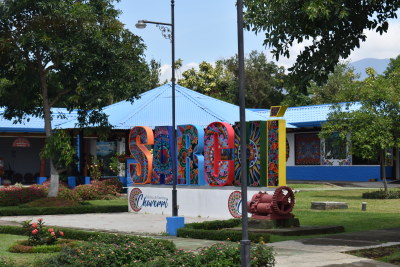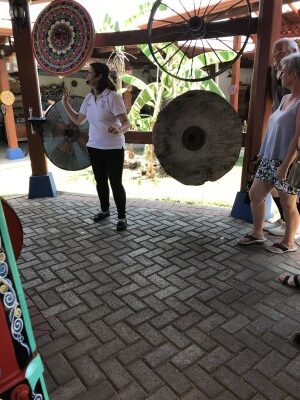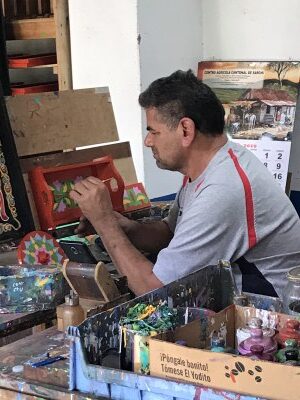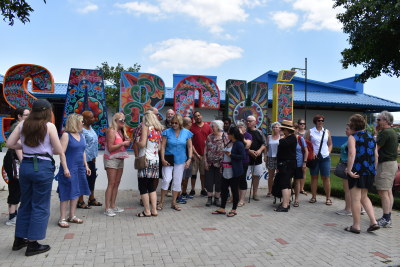Sarchi is known as the cultural capital of the Costa Rica. The oxen cart has contributed to that phenomenon. The oxen cart has a long rich history. It has been around as far back as the 1800’s. The tradition of cart painting has passed from generations in Costa Rica. The custom began in Sarchi. That knowledge has made Sarchi the cultural capital of the Costa Rica. It has a rich artistic heritage and traditional crafts that began in that city. This charming town is famous for its skilled artisans who produce beautiful hand-painted oxcarts, intricate wooden furniture, and colorful handicrafts. The vibrant colors and intricate designs of Sarchi’s products reflect the country’s cultural roots and artistic traditions. In fact, the cart is the national symbol of Costa Rica.

I was traveling from Arenal to San Jose. The guide decided to make a stop in Sarchi. This was my last stop on an exciting, fun filled adventure to Costa Rica. My visit to Sarchi allowed me to witness these craftsmen at work and even try my hand at painting a mini oxcart. It was an opportunity to gain experience about Costa Rica’s rich cultural heritage and take home a unique souvenir.
Sarchi
I was excited on entering the town because of the decorations and souvenirs displayed in the shop windows. I gathered knowledge about the town from our tour guide. The beauty of the small shops and stands decorating the streets were amazing. The town has exceptional gifts and souvenirs.

My first stop was at an oxen cart factory. We did a tour of the facilities. I witnessed the construction of the cart at the factory. The manager gave a presentation. We got an explanation and history of the cart. I got the opportunity to witness the construction of the cart. The artist’s work intrigued me. The intricate design was a tedious task of painting every detail. I explored the workshops and interacted with the artisans. I even tried creating my own unique souvenir. The colorful cart is a big city attraction. I was satisfied that Sarchi was the cultural capital of Costa Rica.
Oxen Cart History

Oxen carts are centuries old, dating back to ancient times. They were a vital mode of transportation for people and goods before the invention of motor vehicles. Oxen pulls the wooden constructed carts. The carts transport farming materials and goods to markets. In addition, they are good for traveling across long distances. The sturdy construction of oxen carts allowed them to navigate rough terrain and carry heavy loads. In fact, the cart was the main source of transportation for the large plantations. They used the ox cart to move coffee beans from the estate to the ports. In addition, the cart moves people and goods across Costa Rica. Today, oxen carts are in use in parts of the world for traditional purposes and as a tourist attraction. They offer a glimpse into the past
.
Sarchi Cart Construction
The process of building a Sarchi oxen cart is a true art form, requiring skilled craftsmen known as “carretas” to meticulously handcraft each part of the cart. The cart is carretas in Spanish. The oxen cart in Sarchi is unique. Each cart has a unique design. Therefore, no two carts are the same. Each design and color are different. The painted designs include flowers, animals, landscapes, linear patterns, and portraits. The cart has two or four wheels. The inspiration for the patterns painted on the cart comes from Costa Rican folklore.

Sarchi oxen cart construction is a traditional craft in Costa Rica that dates to the late 19th century. They used the cart to transport coffee beans across the country. In an earlier blog. I explained how the first settlers arrived in Monteverde. The Mormon used the oxen cart as transportation from San Jose. They used the oxen cart to transfer goods through the dense forest of Monteverde. That was the only means of transportation available at the time.
Sarchi constructed the largest oxen cart in the world in Sarchi in 2006. This massive ox cart is not only a symbol of Costa Rican culture but also holds a Guinness World Record for being the largest of its kind. It is a remarkable sight for anyone visiting Costa Rica. The largest oxen cart display is in the town’s central park.
Cultural Capital of Costa Rica
In 2005 UNESCO (United Nations Educational, Scientific and Cultural Organization) made the oxen cart an Intangible Cultural Heritage. In addition, it became a national labor symbol in 1988. The inhabitants of Costa Rica are proud of their achievements. The town’s lively arts and crafts scene, along with its picturesque setting surrounded by coffee plantations and lush forests, make it a must-visit destination for those seeking a deeper appreciation of Costa Rican culture.

In conclusion, Sarchi truly stands out as the cultural capital of Costa Rica. From its vibrant ox cart tradition to its skilled artisans producing colorful souvenirs. Sarchi offers a unique glimpse into the rich cultural heritage of the country. The town’s welcoming atmosphere and dedication to preserving age-old traditions make it a must-visit destination for anyone seeking an authentic Costa Rican experience.
Whether you are admiring intricately painted oxcarts or exploring local handicraft shops, Sarchi is sure to leave an impression on every traveler. Visit Sarchi and immerse yourself in the cultural capital of Costa Rica as it is a charming town with plenty to offer. I departed from Sarchi after a short visit. I was fully aware why Sarchi is the cultural capital of the Costa Rica.



Surprisingly significant specifics you’ll have said, say thanks a lot for adding. Enrique Artega
Comments appreciated.
Thank you for your entire labor on this web site. My mom really loves managing investigations and it is obvious why. My partner and i learn all regarding the lively tactic you present sensible things through your web site and in addition invigorate response from some others on the situation then our favorite princess is really starting to learn a whole lot. Take advantage of the rest of the year. You have been doing a stunning job. Russell Clemence
Thank you for your comments. It is appreciated and will continue to write to the best of my ability.